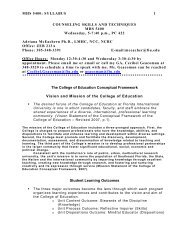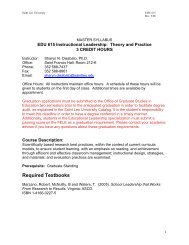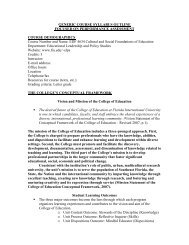2007 - College of Education - Florida International University
2007 - College of Education - Florida International University
2007 - College of Education - Florida International University
Create successful ePaper yourself
Turn your PDF publications into a flip-book with our unique Google optimized e-Paper software.
Urinary Incontinence<br />
Etiology<br />
SUI is diagnosed based on urine leakage concurrent with an increase in abdominal<br />
pressure, with or without pelvic floor prolapse or urethral hypermobility and in the absence <strong>of</strong><br />
bladder detrusor activity. It is generally believed that SUI results from damage to one or more <strong>of</strong><br />
the support mechanisms that stabilize the vesicle neck and proximal urethra.<br />
Known risk factors for SUI include weak connective tissue and PFM, pregnancy, vaginal<br />
delivery with injury to the peripheral nerves, fascia, ligaments, and PFM, obesity, strenuous<br />
work including physical activity, and old age. 2 A National Institute <strong>of</strong> Health consensus panel<br />
developed a list <strong>of</strong> 6 risk factors associated directly with exercise-induced stress urinary<br />
incontinence including “increasing age, female gender, increased parity, heavy physical activity,<br />
high-impact sports, hypoestrogenic amenorrhea, and obesity.” 10 Other factors are less clear,<br />
including strenuous work, exercise, constipation with straining on stool, coughing or other<br />
conditions that can increase abdominal pressure chronically. 3<br />
Activities most commonly associated with a sudden increase in intra-abdominal pressure<br />
are jumping, landings, and dismounts. “The PFM must be able to contract very forcefully and<br />
rapidly to withstand the constant, repetitive deceleration <strong>of</strong> the abdominal viscera on the pelvic<br />
floor caused by repetitive running or jumping.” 8 It is speculated that athletes are more<br />
incontinent during sports that require running into a jump, which adds momentum to the<br />
dynamic impact <strong>of</strong> the abdominal viscera on the pelvic floor. “Force-plate studies have<br />
illustrated a wide range <strong>of</strong> maximum vertical ground-reaction forces for different activities. For<br />
example, long jumpers, who land on their heels, can generate a maximum ground-reaction force<br />
<strong>of</strong> up to 16 times their body weight.” 8 Generalized muscle fatigue, including PMF fatigue, may<br />
also play a role in stress urinary incontinence. 8<br />
Pathophysiology<br />
A major cause <strong>of</strong> SUI is the loss <strong>of</strong> anatomic support <strong>of</strong> the urethra and urethrovesical<br />
junction. This anatomical support is provided anteriorly by the pubo-urethra ligament. The<br />
posterior urethra is pushed anteriorly during activation <strong>of</strong> the pelvic floor muscles. When the<br />
bladder and proximal urethra are well supported, increases in intra-abdominal pressure are<br />
transmitted equally to both structures, and continence is maintained. This occurs at least in part,<br />
because coughing or straining compresses the anterior urethral wall against the well-supported<br />
posterior wall, thereby occluding the lumen. Loss <strong>of</strong> anatomic support allows a displacement <strong>of</strong><br />
the bladder neck causing the opening <strong>of</strong> the posterior aspect <strong>of</strong> the urethrovesical junction during<br />
physically stressful activities. Increases in intra-abdominal pressure are then fully transmitted to<br />
the bladder, and to a lesser extent to the urethra, and urine loss occurs. 15<br />
Chronic increased intra-abdominal pressure may place a woman at risk due to resultant<br />
pelvic relaxation. When the pressure is too high or the levator ani are damaged, this disturbed<br />
anatomic relationship leads to the loss <strong>of</strong> support to the reproductive organs. In the<br />
biomechanical concept <strong>of</strong> pathophysiology <strong>of</strong> pelvic floor dysfunction, it is claimed that the<br />
muscular abdominal wall is strong (voluntary or reflex abdominal contraction) and rigid<br />
prohibiting the levator ani muscles to play the role <strong>of</strong> “shock absorber.” 12<br />
Vaginal delivery causes partial denervation <strong>of</strong> the pelvic floor in most women having<br />
their first baby. Damage to the pudendal nerve releases tension placed on the pelvic floor tissue<br />
and is associated with urinary and fecal incontinence in some women. 12 For some it is likely to<br />
be the first step along a path leading to prolapse <strong>of</strong> the abdominal viscera and/or stress urinary<br />
incontinence. 16 When abnormal intra-abdominal pressure exists, the suspensory mechanism is
















